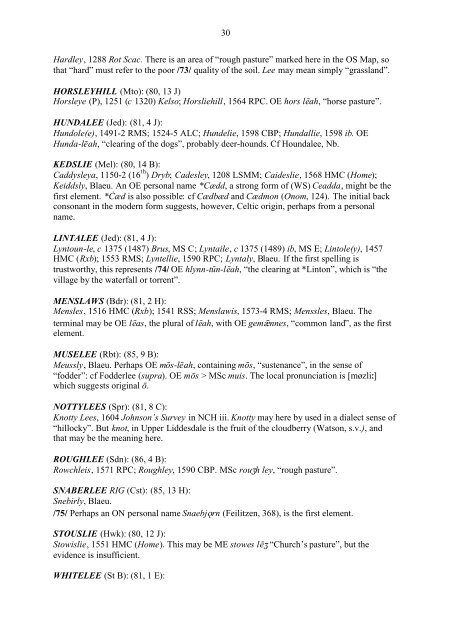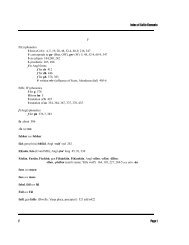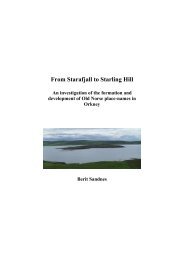May Williamson: The Non-Celtic Place-Names of the Scottish Border ...
May Williamson: The Non-Celtic Place-Names of the Scottish Border ...
May Williamson: The Non-Celtic Place-Names of the Scottish Border ...
Create successful ePaper yourself
Turn your PDF publications into a flip-book with our unique Google optimized e-Paper software.
30<br />
Hardley, 1288 Rot Scac. <strong>The</strong>re is an area <strong>of</strong> “rough pasture” marked here in <strong>the</strong> OS Map, so<br />
that “hard” must refer to <strong>the</strong> poor /73/ quality <strong>of</strong> <strong>the</strong> soil. Lee may mean simply “grassland”.<br />
HORSLEYHILL (Mto): (80, 13 J)<br />
Horsleye (P), 1251 (c 1320) Kelso; Horsliehill, 1564 RPC. OE hors lēah, “horse pasture”.<br />
HUNDALEE (Jed): (81, 4 J):<br />
Hundole(e), 1491-2 RMS; 1524-5 ALC; Hundelie, 1598 CBP; Hundallie, 1598 ib. OE<br />
Hunda-lēah, “clearing <strong>of</strong> <strong>the</strong> dogs”, probably deer-hounds. Cf Houndalee, Nb.<br />
KEDSLIE (Mel): (80, 14 B):<br />
Caddysleya, 1150-2 (16 th ) Dryb; Cadesley, 1208 LSMM; Caideslie, 1568 HMC (Home);<br />
Keiddsly, Blaeu. An OE personal name *Cædd, a strong form <strong>of</strong> (WS) Ceadda, might be <strong>the</strong><br />
first element. *Ċæd is also possible: cf Cædbæd and Cædmon (Onom, 124). <strong>The</strong> initial back<br />
consonant in <strong>the</strong> modern form suggests, however, <strong>Celtic</strong> origin, perhaps from a personal<br />
name.<br />
LINTALEE (Jed): (81, 4 J):<br />
Lyntoun-le, c 1375 (1487) Brus, MS C; Lyntaile, c 1375 (1489) ib, MS E; Lintole(y), 1457<br />
HMC (Rxb); 1553 RMS; Lyntellie, 1590 RPC; Lyntaly, Blaeu. If <strong>the</strong> first spelling is<br />
trustworthy, this represents /74/ OE hlynn-tūn-lēah, “<strong>the</strong> clearing at *Linton”, which is “<strong>the</strong><br />
village by <strong>the</strong> waterfall or torrent”.<br />
MENSLAWS (Bdr): (81, 2 H):<br />
Mensles, 1516 HMC (Rxb); 1541 RSS; Menslawis, 1573-4 RMS; Menssles, Blaeu. <strong>The</strong><br />
terminal may be OE lēas, <strong>the</strong> plural <strong>of</strong> lēah, with OE gemnnes, “common land”, as <strong>the</strong> first<br />
element.<br />
MUSELEE (Rbt): (85, 9 B):<br />
Meussly, Blaeu. Perhaps OE mōs-lēah, containing mōs, “sustenance”, in <strong>the</strong> sense <strong>of</strong><br />
“fodder”: cf Fodderlee (supra). OE mōs > MSc muis. <strong>The</strong> local pronunciation is [møzli;]<br />
which suggests original ō.<br />
NOTTYLEES (Spr): (81, 8 C):<br />
Knotty Lees, 1604 Johnson’s Survey in NCH iii. Knotty may here by used in a dialect sense <strong>of</strong><br />
“hillocky”. But knot, in Upper Liddesdale is <strong>the</strong> fruit <strong>of</strong> <strong>the</strong> cloudberry (Watson, s.v.), and<br />
that may be <strong>the</strong> meaning here.<br />
ROUGHLEE (Sdn): (86, 4 B):<br />
Rowchleis, 1571 RPC; Roughley, 1590 CBP. MSc rouZh ley, “rough pasture”.<br />
SNABERLEE RIG (Cst): (85, 13 H):<br />
Snebirly, Blaeu.<br />
/75/ Perhaps an ON personal name Snaebjrn (Feilitzen, 368), is <strong>the</strong> first element.<br />
STOUSLIE (Hwk): (80, 12 J):<br />
Stowislie, 1551 HMC (Home). This may be ME stowes lēZ “Church’s pasture”, but <strong>the</strong><br />
evidence is insufficient.<br />
WHITELEE (St B): (81, 1 E):




